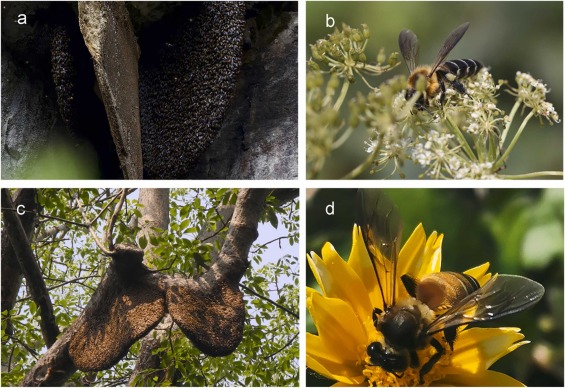Anthropogenic climate change has a significant impact on the geographical distribution and phenology of species. Apis laboriosa and Apis dorsata are two species of giant honeybees distributed in Asia, and play important roles in their ecosystems. Understanding species ranges, drivers and the possible impacts of climate change on these species can provide a basis for ensuring sustainable management and targeted conservation into the future.
In a study published in Global Ecology & Conservation, researchers from Xishuangbanna Tropical Botanical Garden (XTBG) analyzed the key factors affecting the distribution of the two giant honeybee species, as well as their potential suitable areas and possible co-existence regional changes under the global climate change.
The researchers collected 160 occurrence records of A. laboriosa and 387 A. dorsata published or observed in the field between 1960 and 2021 (after removing localities within a 5 km radius). They simulated the potentially suitable areas of two species under current conditions using Maxent using eight climatic variables and fourteen environmental variables, and simulated the potential habitats of the past and future of the two species using eight climate variables in the Community Climate System Model version 4 (CCSM4) model to understand shifting distributions, and facilitate targeted management.
The results showed that temperature-related factors are the main drivers of distribution for both species. Among the variables, temperature seasonality and mean temperature of coldest quarter showed the strongest influence on the distributions of two giant honeybees.
The results also showed that A. dorsata distribution range shrank significantly as the temperature became more humid and hotter after the Last Glacial Maximum (LGM). The distribution of A. laboriosa has always been concentrated in the Himalayas and Hengduan Mountains, and the contraction and expansion of ranges may have occurred in this region.
“Under the current climate scenario, the species overlap in Nepal and Yunnan of China, with low niche overlap index. Only 6.6% of overlapping distribution is currently protected, and further work is needed to protect these key areas,” said PENG Yanqiong of XTBG.
Contact
PENG Yanqiong Ph.D Principal Investigators
Key Laboratory of Tropical Forest Ecology, Xishuangbanna Tropical Botanical Garden, Chinese Academy of Sciences, Mengla, Yunnan 666303, China
E-mail: pengyq@xtbg.ac.cn

Apis laboriosa and Apis dorsata in the fields. (Image by HUANG Manjuan)

